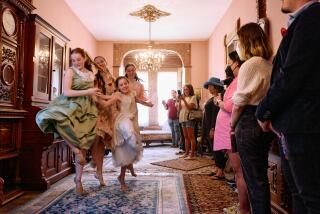Dances With Balanchine--a Muse’s Tale
- Share via
At once startling in its revelations about the ballet world and compassionate in its view of human frailty, the documentary “Suzanne Farrell: Elusive Muse” comes to the PBS “Dance in America” series on Wednesday, in a version 30 minutes shorter than the one nominated for an Academy Award this year.
Directed by Anne Belle and Deborah Dickson, the 90-minute telecast extends and deepens the oral history of New York City Ballet presented in Belle’s superb “Dancing for Mr. B.: Six Balanchine Ballerinas,” first shown on PBS in 1990 and currently available from Nonesuch home video. Once again, vintage performance clips alternate with intimate reminiscences of working with choreographer George Balanchine and, in Farrell’s case, becoming trapped in an unconsummated love affair with him--one so overwhelming that she says she considered suicide.
“I think how you dance is who you are, and that’s what he fell in love with,” Farrell comments. And, of course, her dancing proved one of the acknowledged wonders of the age: incredibly free and fearless technically, with fabulous liquid legwork that belied the speed and precision of City Ballet neoclassic style. “The last great muse for Balanchine,” says former Farrell partner Jacques d’Amboise, perhaps the most outspoken and vibrant commentator in the film.
Eventually, Farrell’s life came to resemble the plot of “The Red Shoes”: When she married fellow City Ballet dancer Paul Mejia in 1969, Mejia’s roles were taken away, and tensions increased to the point where the couple left the company to dance for Maurice Bejart in Brussels. Reconciliation with Balanchine followed in 1975, and from it came the late masterworks created for Farrell: “Chaconne,” “Davidsbundlertanze” and “Mozartiana.” Balanchine died in 1983, and Farrell gave her last performance six years later. She now restages Balanchine ballets all over the world.
Farrell tells much of this story herself, with her mother, former colleagues and Bejart adding their perspectives and the editing (credited to Dickson) often creating uncanny matches between the narration and a massive collection of backstage photos. In addition, music tracks have been carefully synchronized with excerpts from rarely seen silent archival films such as “Don Quixote” from 1965, in which Balanchine himself played the title role opposite Farrell as Dulcinea.
For economic reasons, Belle told The Times recently, the accompaniments to some of Farrell’s more recent classic performances also had to be reconstructed or synthesized; the music rights weren’t affordable, she explained. Moreover, no footage whatsoever was available from the PBS “Live From Lincoln Center” series because of the original union contracts. So there are no passages from “Mozartiana,” which Belle said “was crushing to me and Suzanne.” Also unavailable: any interview with Peter Martins, Farrell’s last great partner and currently the head of New York City Ballet. “I couldn’t get him to agree to talk,” Belle said. “He said he didn’t have the time.”
Martins’ reluctance may well have been prompted by shifting critical and public attitudes in the post-Balanchine era, which have increasingly downgraded his maintenance of the Balanchine repertory and cast Farrell as keeper of the flame. However, the film sidesteps this controversy--”Suzanne doesn’t really want to be quoted saying these things,” Belle said. “It’s up to other people, journalists and commentators, to say what they feel.”
Originally 115 minutes when it premiered in 1996 at the New York Film Festival, the film was subsequently tightened to 105, Belle said. However, PBS insisted that it be cut to 84 minutes to allow the network’s own credits, teaser and sponsor list to be added within a 90-minute format. A number of scenes thus had to be dropped, most crucially Farrell’s account of her harrowing audition for Balanchine and the events leading to her triumphant final performance and retirement. No “edited for television” warning was allowed in the credits, Belle said, nor will viewers be told that the home video edition advertised at the end of the show is the longer, final cut.
Jac Venza, executive producer for the “Great Performances” series, told The Times recently that the film was always contractually limited to a 90-minute PBS running time. “The subject deserves no more than 90 minutes, frankly,” he commented. “I don’t see that anything will be lost to the broad audience.” When a project comes in at an irregular length, his choice is “to fill the program [to the next hour or half-hour] or edit the program,” he said.
So why not fill “Suzanne Farrell: Elusive Muse” to two hours with dancing footage of her from the PBS vaults?
“Station managers feel that very few things in the world are worth ruining their whole evening’s schedule,” he said.
PBS doesn’t cut Hollywood features or opera, Venza said, but the Royal Ballet performances of “Sleeping Beauty” and “La Bayadere,” New York City Ballet’s “Jazz: Six Syncopated Movements” and Mark Morris’ “The Hard Nut” were all shortened. Venza said that low ratings give him no other choice. “There is such a small audience for dance that station managers want us to stop dance programs, no matter how brilliant they are,” he explained. But he insisted that other art forms also feel the pinch:
“We had the 36 works of William Shakespeare,” he pointed out, “and when I got a piece that was four hours and six minutes long, I asked [the original British producers] to find a way to cut the six minutes.”
* “Suzanne Farrell: Elusive Muse” screens on the PBS “Dance in America” series at 9 p.m. Wednesday on KCET-TV Channel 28.
More to Read
The complete guide to home viewing
Get Screen Gab for everything about the TV shows and streaming movies everyone’s talking about.
You may occasionally receive promotional content from the Los Angeles Times.






